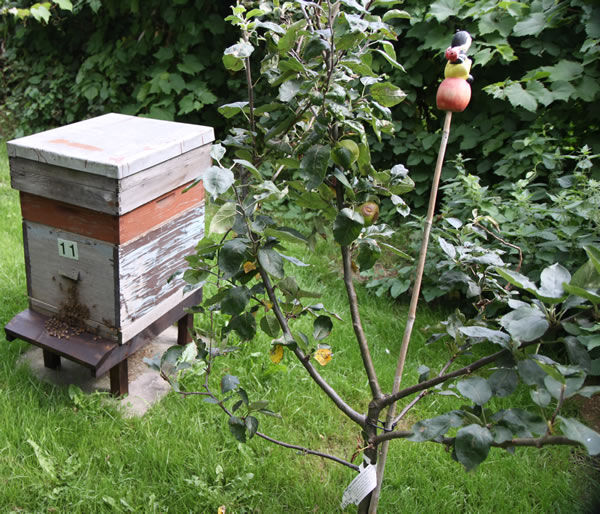Under One Roof: Beehive Management During the Swarming Season in a Single Hive by Nick Withers

Natural History of Swarming – Colony Reproduction
Colonies grow rapidly in Spring, fuelled by winter stores at first, then the spring flow. The growth is to get enough bees for successful swarming.
Swarming triggers:
Crowding (brood nest especially).
Less queen pheromone (as the queen gets older).
Poor pheromone distribution (caused by crowding).
Queen pheromone suppresses queen cell raising and swarming preparation by worker bees. Queens produce less pheromone as they age. As a result hives with older queens swarm more readily. Crowding has been shown to disrupt pheromone distribution among worker bees.
Swarming preparations:
Queen cells produced.
Changes to worker behaviour.less foraging, more resting.
gorging honey.
less brood rearing.
queen fed less.
The appearance of queen cells is the first sign of swarming for the beekeeper. The changes in worker behaviour may show up as a less active hive than normal. The effect is to conserve the workers’ working life and ‘prime’ them for wax production in the new nest to be built by the swarm. Starving the queen lightens her ovaries so she can fly with the swarm.
Timetable for parent hive or nest:
Day 1. 1st eggs laid in queen cups.
Day 8. 1st cells sealed.
Day 8+ swarm issues (prime swarm).
Day 16 1st virgin queen emerges.
Day 16+ virgin queens destroy sealed cells and fight each other until only one is left.
OR: Day 16+ workers keep virgin queens in cells and protect cells from emerged virgins. One or two more swarms (casts) emerge.
Day 21+ the remaining queen mates and heads a new colony in the old nest.
The start of swarming may be fairly ill defined. Some workers may let the queen lay eggs in queen cups, only for other workers to eat them. Queen cell development will proceed when there are enough workers ‘turned on’ to swarming.
Issue of swarms may be delayed several days in bad weather, even to the time when virgin queens are ready to emerge.
Newly emerged virgin queens seek each other out and fight to the death. They also attempt to bite into still sealed cells to sting the occupant. They signal their presence to each other by making a sound called piping:
They make the sound by pressing themselves against the comb and vibrating their flight muscles without moving their wings. Other queens respond, including those still in their cells which make a lower pitched sound called ‘quacking’. If you hear these sounds from one of your hives, it is likely the prime swarm has gone and issue of a cast is imminent.
The size of the colony and in particular the number of adult workers helps decide if there will be casts. Large colonies may produce two, or even three casts in succession.
Workers feed the virgin queens they trap in their cells.
No (more) casts will be produced if there are no more queens yet to emerge from queen cells.
Hive colonies are sometimes unnaturally big at the time of swarming and may produce too many casts, leaving a colony unlikely to survive.
What the swarm does:
Swarms usually emerge around the middle of a fine day and cluster nearby. Scout bees then go searching for a new home in such places as hollow trees, chimneys and unoccupied hives. They dance on the surface of the cluster to indicate a good site and get other bees to go and look. When all the scouts agree on the best site the swarm flies off and enters the new nest.
Swarms use the same round or waggle dances to find a new home as they do for directing foragers to food sources. They are very much attracted to places where bees have lived before and will readily occupy and renovate combs left by a deceased colony. This has survival value despite the disease risk because it saves them the energy of building new comb.
Swarms will choose fairly small cavities to nest in if they can, with enough room for about 45lbs of stores for the winter. The large space provided by a brood box and several supers in not what they choose naturally.
The new nest:
The swarm then works very hard to build new combs from scratch, raise new worker bees and collect nectar and pollen to supply the demand and create a reserve of stores.
Swarming is a risky business for wild bees. On average only ~25% of prime swarms in forests survive their first winter whereas ~75% of established nests get through.


